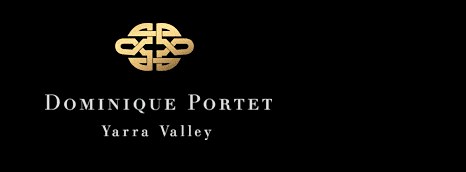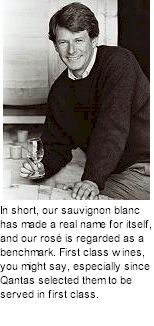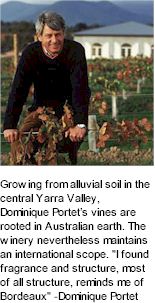


The Portet family lays claim to a singular accolade in the Australian wine Industry. Dominique is the ninth generation in his family to be committed to winemaking, yet he is the first to establish a winery and label bearing the family name. Since 1976 he has lived in Australia to create a family. "I'm at home here, I think my roots are here now." Although he now calls Australia home, Dominique Portet's bond with Bordeaux cannot be broken. His family has had links with the wine industry since 1780. "It is longer, but most of the records were lost during the revolution." The earliest document dated 1720, relates to the sale of Eaux de vie by Portet to the Martells.

The son of Andre Portet, regisseur (vineyard & winery manager) of Chateau Lafite-Rothschild in Pauillac, Dominique's training began at one of the world's most illustrious red wine properties. He qualified at the Montpellier University of Oenology and during a compulsory one year military service was the legion's wine purchasing adviser. With each French soldier receiving his daily wine ration, the army's morale was at stake. Further enhancing his qualifications, Dominique spent vintages in the Medoc, the Rhone Valley, Provence and with world Champagne giant Moet et Chandon.
Dominique was inclined to join his older brother Bernard in the Napa Valley of California where he would spend three vintages, and at the same time commencing a search to find vineyards to rival that of his native Bordeaux. His quest lead him to a newly planted vineyard owned by a distant millionaire. Portet was only going to stay for a year. Bernard Portet had selected the Taltarni site at Moonambel in Victoria’s Pyrenees region, and Clos Du Val owner John Goelet had invested the money, and they were seeking a winemaker. Dominique, who had worked three vintages with his brother, put his hand up.
Dominique had a strong vision for Taltarni that never faltered, creating powerful red wines intended for ageing. The wines were modelled on French techniques, lengthy fermentation times and the use of riper grapes. Along with the growth and development of the vineyards, the winery, and a market extending to thirty countries, he also developed the premium Tasmanian sparkling wine house of Clover Hill. Taltarni’s move into serious sparkling wines, establishing the Clover Hill vineyard in Tasmania was considered a bold move, but Portet knew it had the edge on quality. A pioneer of the renaissance of the Victorian and Tasmanian wine industries, he was steadfast in his vision to initiate highly regarded styles of wines.

After a break from winemaking, six months in Provence and two vintages away from the industry, 2000 would see the beginning of the Dominique Portet label. Looking around for suitable winery sites he decided on the Yarra Valley, attracted to its quality and style. "I found the fragrance, aromatics and structure - most of all the structure - reminds me of Bordeaux," he explains. Dominique leased space at Yering Station prior to setting up his own cellar door facility on the Maroondah Highway Coldstream.
"I found the fragrance, aromatics and structure - most of all the structure - reminds me of Bordeaux," he explains. Dominique leased space at Yering Station prior to setting up his own cellar door facility on the Maroondah Highway Coldstream.
The Dominique Portet label features an emblem in the form of an arabesque, by the only jeweller to be welcomed as an associate of the Academie des Beaux-Arts, Ilias Lalaounis. A sinuous unbroken line that suggests grace, strength, purity of line, and unbroken bonds. It symbolises the links and close bonds between generations, families and continents, within the context of an artistic drive and expression. These are the qualities that Dominique Portet strives to embody in his own wines.
The tradition associated with the Portet family continues today with wife Julia and sons Benjamin, Thomas and Henri, all having close association with the production of Portet Winemakers. A tenth generation is just upon the horizon for the Portet family, entrusting also an undoubtable commitment to high quality winemaking of exceptional standards.
